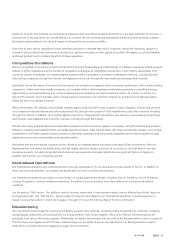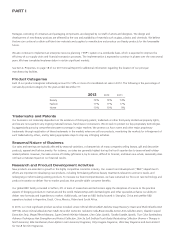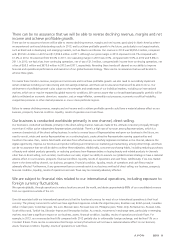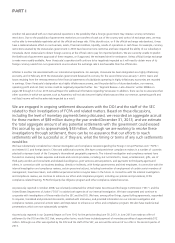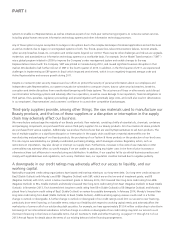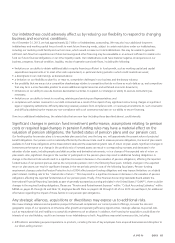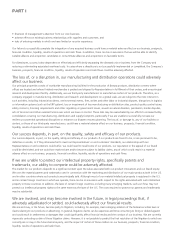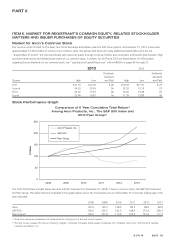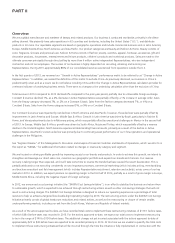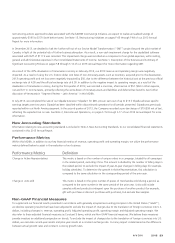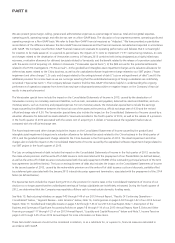Avon 2013 Annual Report Download - page 22
Download and view the complete annual report
Please find page 22 of the 2013 Avon annual report below. You can navigate through the pages in the report by either clicking on the pages listed below, or by using the keyword search tool below to find specific information within the annual report.PART I
systems to enable our Representatives, as well as initiatives as part of our multi-year restructuring programs, to outsource certain services,
including global human resources information technology systems and other information technology processes.
Any of these systems may be susceptible to outages or disruptions due to the complex landscape of localized applications and architectures
as well as incidents due to legacy or unintegrated systems or both, fire, floods, power loss, telecommunications failures, terrorist attacks,
cyber security breaches, break-ins, corruption and similar events beyond our control. There may be other challenges and risks as we upgrade,
modernize, and standardize our information technology systems on a worldwide basis. For example, Service Model Transformation (“SMT”)
was a global program initiated in 2009 to improve the Company’s order management system and enable changes to the way
Representatives interact with the Company. SMT was piloted in Canada during 2013, and caused significant business disruption in that
market. We decided to halt further roll-out of SMT in the fourth quarter of 2013. In addition, in the third quarter of 2011, we experienced
challenges in implementing an ERP system in Brazil which impacted service levels, which in turn negatively impacted average order and
Active Representative and revenue growth during 2011.
Despite our network/ cyber security measures and our efforts to protect the security of personal information about our employees and
independent sales Representatives, our systems may also be vulnerable to computer viruses, data or cyber security breaches, break-ins,
corruption and similar disruptions from unauthorized tampering with these systems. The occurrence of these or other events could disrupt
our information technology systems and adversely affect our operations, as well as cause damage to our reputation, financial obligations to
third parties, fines, penalties, regulatory proceedings and private litigation with potentially large costs, and could also result in deterioration
in our employees’, Representatives’ and customers’ confidence in us and other competitive disadvantages.
Third-party suppliers provide, among other things, the raw materials used to manufacture our
Beauty products, and the loss of these suppliers or a disruption or interruption in the supply
chain may adversely affect our business.
We manufacture and package the majority of our Beauty products. Raw materials, consisting chiefly of essential oils, chemicals, containers
and packaging components, are purchased from various third-party suppliers for our Beauty products. All of our Fashion & Home products
are purchased from various suppliers. Additionally, we produce the brochures that are used by Representatives to sell Avon products. The
loss of multiple suppliers or a significant disruption or interruption in the supply chain could have a material adverse effect on the
manufacturing and packaging of our Beauty products, the purchasing of our Fashion & Home products or the production of our brochures.
This risk may be exacerbated by our globally-coordinated purchasing strategy, which leverages volumes. Regulatory action, such as
restrictions on importation, may also disrupt or interrupt our supply chain. Furthermore, increases in the costs of raw materials or other
commodities may adversely affect our profit margins if we are unable to pass along any higher costs in the form of price increases or
otherwise achieve cost efficiencies in manufacturing and distribution. In addition, if our suppliers fail to use ethical business practices and
comply with applicable laws and regulations, such as any child labor laws, our reputation could be harmed due to negative publicity.
A downgrade in our credit ratings may adversely affect our access to liquidity, and our
working capital.
Nationally recognized credit rating organizations have issued credit ratings relating to our long-term debt. Our long-term credit ratings are
Baa3 (Stable Outlook) with Moody’s and BBB- (Negative Outlook) with S&P, which are on the low end of investment grade, and BB
(Negative Outlook) with Fitch, which is below investment grade. In February 2013, Fitch lowered their long-term credit rating from BBB-
(Negative Outlook) to BB+ (Stable Outlook) and Moody’s lowered their long-term credit rating from Baa1 (Negative Outlook) to Baa2 (Stable
Outlook). In November 2013, Fitch lowered their long-term credit rating from BB+ (Stable Outlook) to BB (Negative Outlook) and Moody’s
placed Avon’s long-term credit rating of Baa2 (Stable Outlook) on review for possible downgrade. In February 2014, Moody’s lowered their
long-term credit rating from Baa2 (Stable Outlook) to Baa3 (Stable Outlook). Additional rating agency reviews could result in a further
change in outlook or downgrade. A further change in outlook or downgrade of our credit ratings could limit our access to new financing,
particularly short-term financing, on favorable terms; reduce our flexibility with respect to working capital needs; and adversely affect the
market price of some or all of our outstanding debt securities. For example, we have approximately $159.4 million outstanding in short-term
borrowings of our international subsidiaries. A further change in outlook or downgrade of our credit ratings may limit our access to such
short-term financing in the future on favorable terms, if at all. See Note 5, Debt and Other Financing, on pages F-17 through F-21 of our
2013 Annual Report for details about the terms of our existing debt and other financing arrangements.



